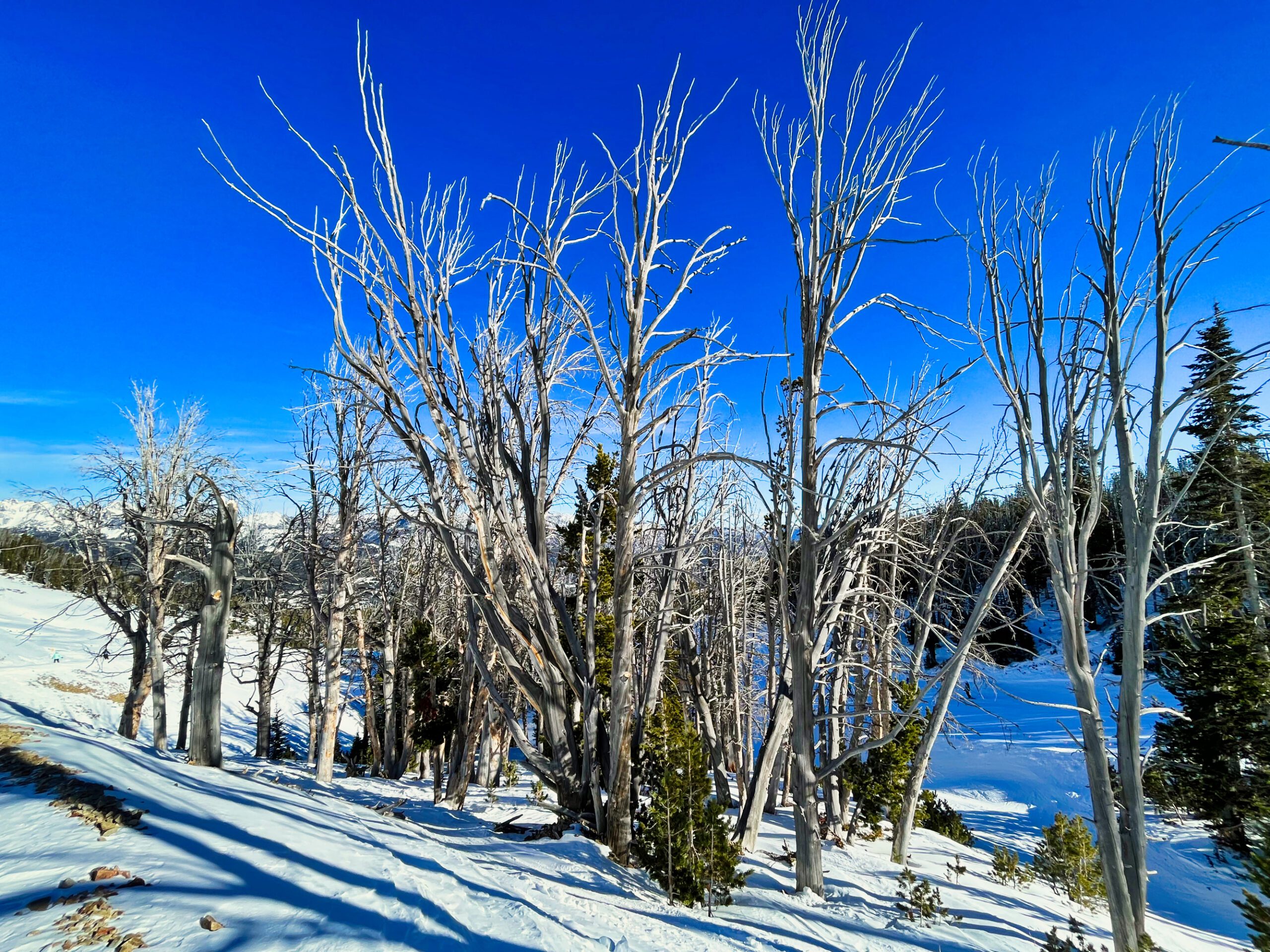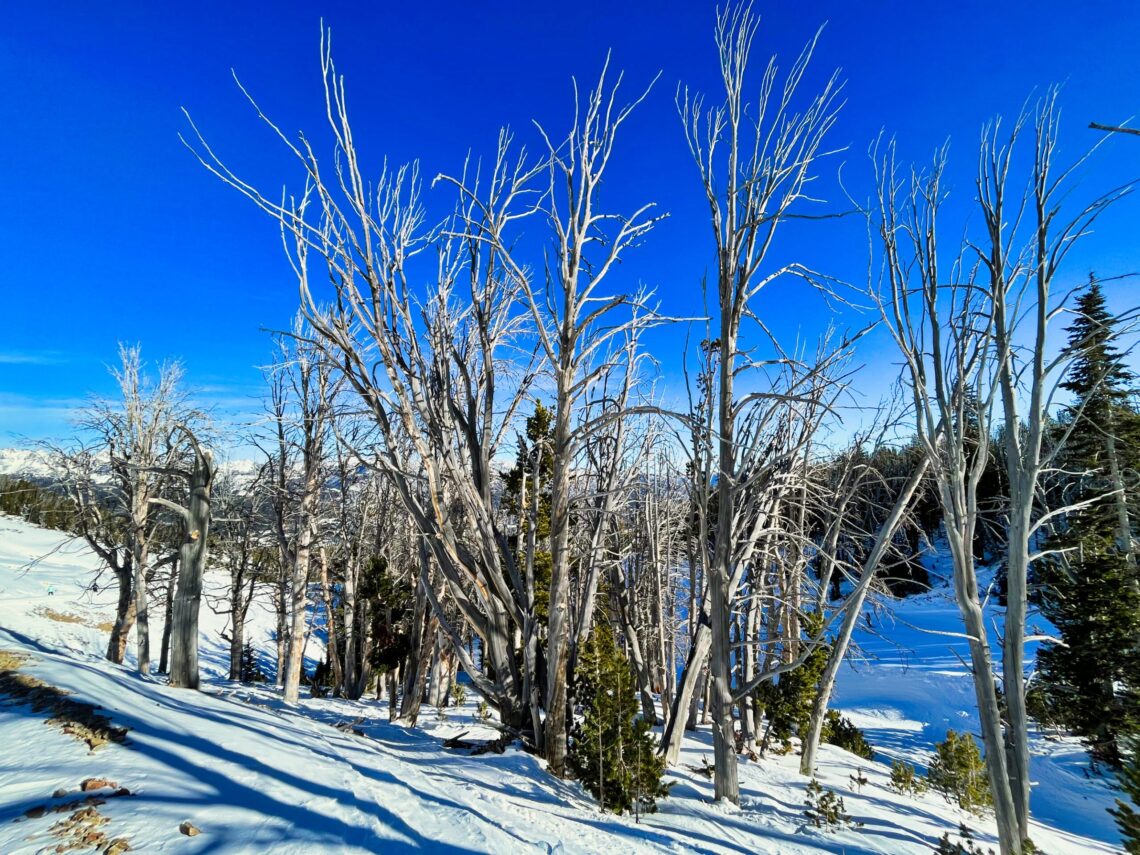By Paul Swenson EBS COLUMNIST
Near the top of the Swift Current lift at Big Sky Resort, the majority of the trees in the forest are dead. There is a transition around 8,400 feet of elevation to where the whitebark pine (Pinus albicaulis) becomes the more populous tree and what has happened to this tree over the last several decades is a harbinger of things to come.

If you have been skiing here since the mid-1970s and have pictures from the top of the gondola or the base of the triple chair, you will see most of these trees were alive for the first 15 years of Big Sky Resort’s existence. Then as you shuffle through your memory or photos into the ‘80s then ‘90s you start to see the whitebark’s needles starting to turn red and the trees starting to die off. This trend continues over the next 10 years or so until the early 2000s when most of today’s dead trees died off.
What was the cause and what happens next?
There are a myriad of factors that have gone into the demise of the whitebark pine: Drought, beetles, fungus, competing species and a warming climate. Let’s start with drought.
Comparing snowpack water equivalents and summer precipitation amounts from 1960-1985 with the same data from 1986-2011, there is a striking difference. Throughout the Rocky Mountains of Montana, Wyoming and Colorado, themore recent span, as seen on the USDA Cumulative Drought Severity Index, shows drastic increases in drought severity and extent. This affects pine trees and their natural defense against wood-boring beetles. During a normal water year, a pine tree is able to fend off invading beetles by exuding sap into their boreholes, which pushes the beetles out before they have a chance to lay eggs. But during a drought, the trees cannot produce the quality sap needed for this defense, and a beetle infestation occurs.
At the same time, a fungus called white pine blister rust (Cronartium ribicola) takes advantage of the drought-stressed trees. This fungus matures and spreads its spores from mid-August to September. The spores infect the trees most efficiently during periods of higher humidity in the fall that follows a dry summer. Spores land on the needles and enter through their stomata, the opening in the leaves of a tree. The fungus then grows down the needle into the bark of the tree where it spreads and kills the tree in about two to four years. Blister rust is a fungus that was accidentally introduced with Eastern Whitebark pine seedlings from Germany or France around 1900. From there it has spread across the entire North American continent.
In addition to, or a cause of, increasing drought in the West, rising temperatures have a whole host of effects on the whitebark pine and its survival. This tree thrives just below the tree line, a place of extreme conditions. The growing season is short, and temperatures are very cold in the winter with lots of snow and wind. These pines evolved into this niche and until recently, did not have much competition. But with a warming climate, other faster-growing tree species like subalpine fir, juniper, and limber pine are outcompeting the whitebark and invading its high elevation niche. The whitebark pine can seed itself into higher elevations, but that takes a very long time.
So is there some good news? Of course. Like any species, there are genetic variations within a population that have survived the onslaught of beetles, fungus and climate change. You can find these trees in the middle of devastated forests around Lone Mountain, the Spanish Peaks, and other alpine environments in the Greater Yellowstone Ecosystem. Foresters can harvest the seeds from these pinecones and find locations to plant seedlings at higher elevations, or in protected areas that will not be developed.
There is also the “Johnny Appleseed” of the alpine environment. Perhaps the savior of the whitebark pine. It is the Clark’s nutcracker.

There is a mutualistic dependance between the whitebark pine and the nutcracker. The pinecones of these trees have a very difficult time opening on their own and spreading seeds. Therefore, the tree depends on the bird to break open the pinecone and disperse the seeds. In a single summer, the Clark’s nutcracker will harvest thousands of pinenuts and cache them throughout its range. Sometimes these seeds are transported miles away from the host trees. The birds cache seeds underground and many will be abandoned or forgotten, giving the seeds the opportunity to germinate and grow, perhaps starting a new grove of hardy, resistant pines at the right location for survival.
With greater awareness and support from people, the whitebark pine might not be doomed. As resistant trees outlast the many dying whitebarks, Clark’s nutcracker will play a key role as the species looks to turn over a new leaf—or pinecone.
Paul Swenson has been living in and around the Big Sky area since 1966. He is a retired science teacher, fishing guide, Yellowstone guide and naturalist. Also an artist and photographer, Swenson focuses on the intricacies found in nature.













